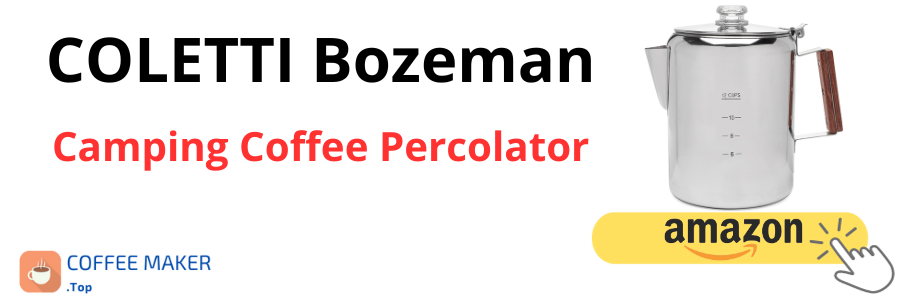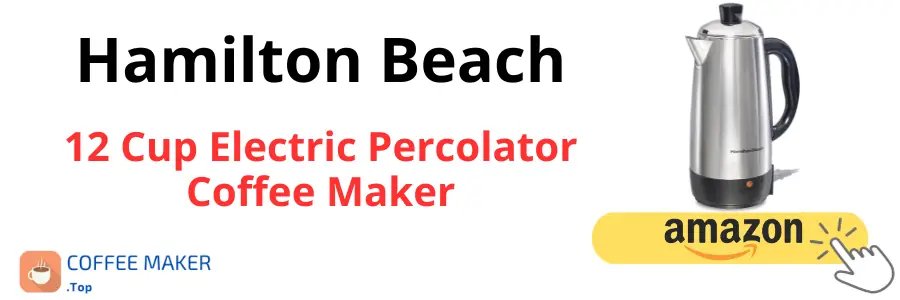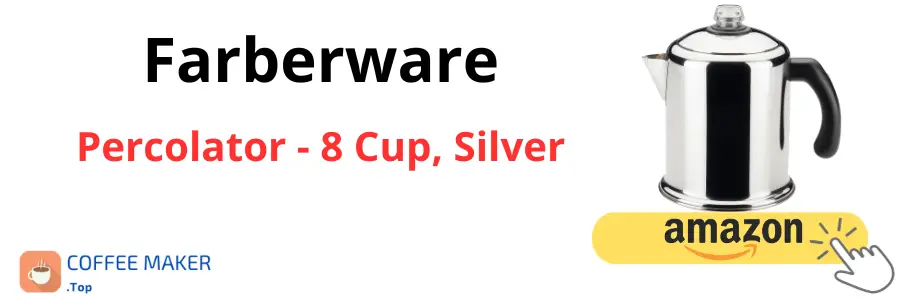In a world dominated by high-tech espresso machines, the humble percolator shines as a symbol of the enduring simplicity and efficiency of coffee brewing. Widely recognised in offices and large gatherings, the percolator transcends mere nostalgia, offering a coffee with a unique taste.
This article delves into the world of percolators, tracing their historical roots and explaining in detail the fascinating process of coffee extraction. Discover the reasons behind the continued use of percolators in a variety of environments and learn how to choose the ideal percolator for your coffee brewing needs.
What is a coffee Percolator?
The term “coffee percolator” derives from “percolate,” which describes passing a soluble substance through a permeable material to create a soluble compound. In the context of coffee preparation:
- Soluble substance: The primary soluble substance in a coffee percolator is water.
- Permeable material: Ground coffee is the permeable material through which water flows.
- Resulting soluble compound: The outcome of this process is the aromatic and flavourful coffee that we all know and love.
While traditional percolators require an open flame or stovetop heating, modern versions are predominantly electric. One of the most notable qualities of a coffee percolator is its substantial capacity, allowing you to brew 15 to 20 litres of coffee at once. This makes percolators exceptionally practical for settings like offices and large gatherings, where a steady supply of coffee is often needed.
What does a coffee Percolator look like?
Coffee percolators feature a simple and practical design. On the exterior, you’ll notice a large cylindrical metal container, typically stainless steel. This container is equipped with a pair of temperature-insulated handles for safe handling.
Upon closer inspection, the interior of a percolator reveals a unique setup. The bottom part of the container is slightly deeper than the rest. The central element of a percolator is a removable vertical tube, which is connected to a vessel or a perforated filter, where you pour the ground coffee. On the exterior of the percolator, you’ll find the unmistakable faucet-like spout, which you can open manually to dispense coffee into cups.
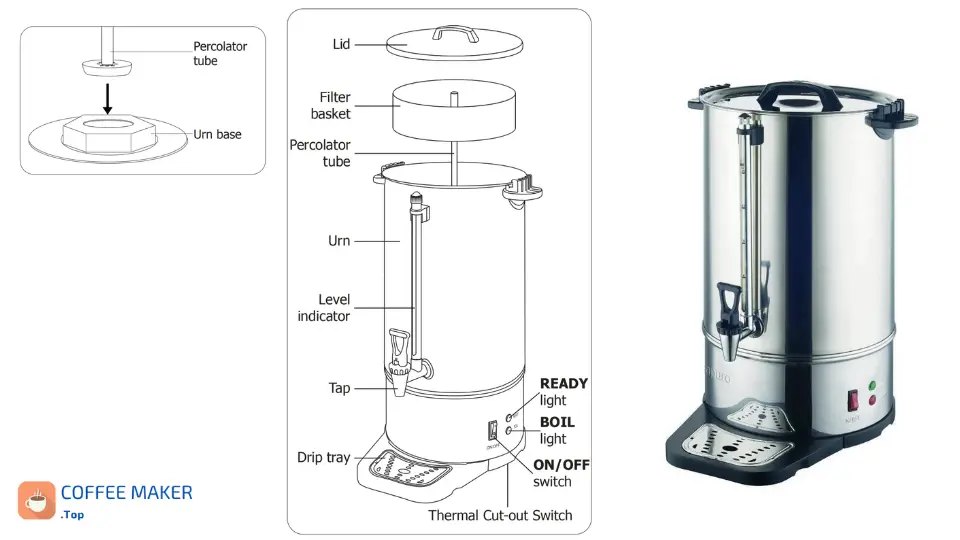
The result of brewing coffee in a percolator may surprise some, as it delivers a rich and flavorful brew when prepared correctly. Contrary to common misconceptions, percolator coffee can exhibit a bold taste and body, making it a preferred choice for those who appreciate robust coffee profiles.
What sets a coffee Percolator apart from other coffee machines?
A coffee percolator is undoubtedly a coffee maker, as it serves the primary purpose of brewing coffee. Nevertheless, a fundamental disparity distinguishes it from conventional coffee machines – the crucial absence of pressure.
In traditional coffee-making methods, such as espresso machines and Italian Moka pots, water is forced through the coffee grounds under pressure. For instance, in an Italian Moka pot, water vapour builds pressure in the lower chamber, and propels the brewed coffee upwards:
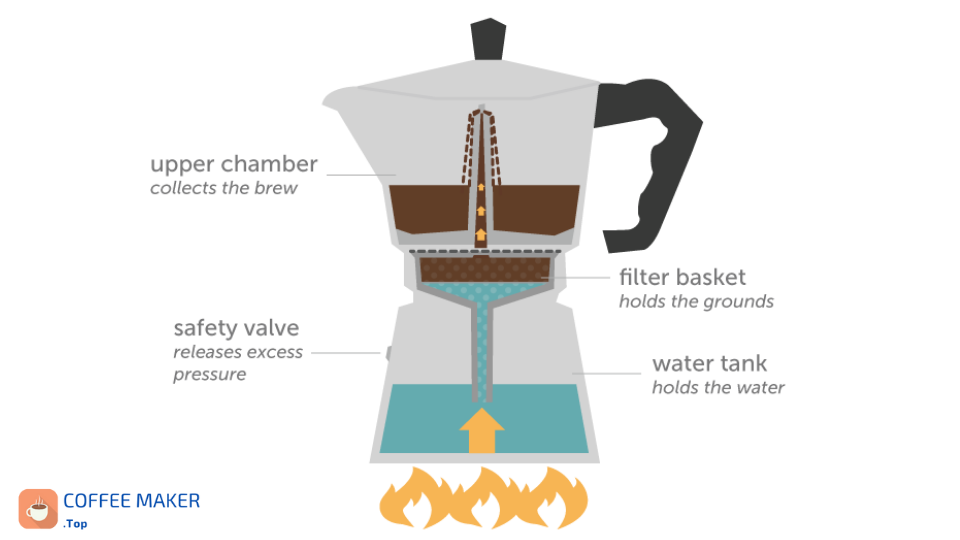
In contrast, the coffee percolator employs an entirely different mechanism. It relies on the natural movement of liquids, driven by variations in temperature. As water in the percolator’s lower chamber heats, it ascends through a vertical tube, passing through the ground coffee in the upper chamber. This infusion process continues as the water circulates, with each cycle enriching the coffee’s flavour and aroma.
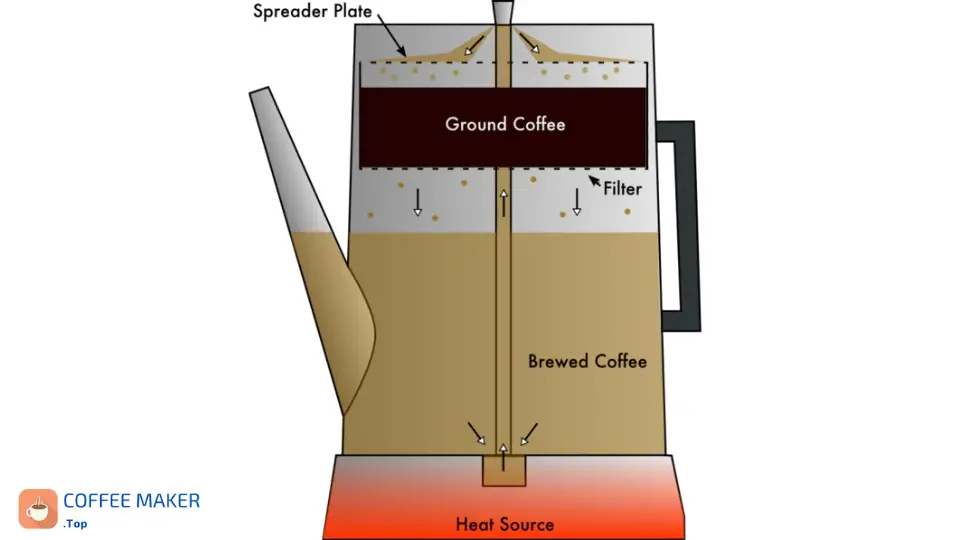
The absence of pressure in percolation is responsible for the distinct characteristics of percolated coffee. It produces a robust and full-bodied brew, appreciated by those who relish a hearty coffee flavour. This departure from pressurized brewing methods lends percolated coffee its unique taste, making it an enticing choice for enthusiasts seeking a different coffee experience.
How to use a coffee Percolator
Once you’ve grasped the inner workings of a coffee percolator, it’s time to roll up your sleeves and brew that perfect cup of coffee. Regardless of your percolator’s model, the essential steps you should follow are as follows:
- Select the right grind: Start using a coarse coffee grind, similar to what you would employ in a French press or plunger coffee machine. This coarser grind size is ideal for percolation, allowing the water to infuse the coffee grounds effectively.
- Prepare the Percolator: Open the percolator and add the desired amount of water to the bottom chamber. The amount of water will depend on your coffee-to-water ratio and the number of cups you want to brew.
- Add ground coffee: Place the coffee in the vessel or upper filter at the top of the vertical tube. The quantity of coffee will depend on your taste preferences and the percolator’s capacity.
- Assemble and seal: Close the upper portion, ensuring a secure seal to prevent steam or coffee grounds from escaping during brewing.
- Apply heat: If you’re using an electric percolator, plug it in and switch it on. For stovetop percolators, place it on a heat source, such as a stovetop burner or campfire.
- Monitor the process: The moment of anticipation arrives when the water within the percolator reaches the right temperature. The water will bubble and percolate through the tube, infusing it with the coffee grounds.
- Timing is everything: Coffee is ready when it reaches your preferred strength and flavour. This can vary, so keep an eye on the percolation process to avoid over-extraction.
One vital tip to remember is that percolated coffee is at its best when consumed within the first hour. Beyond this time frame, consider removing the coffee from the percolator to prevent overcooking or over-extraction if the brewing process reactivates.
The best percolator coffee maker
And finally, we go with our rankings to discover the best percolator of the market. Of the different options we can currently find to buy a multi-cup percolator, we have highlighted three by different criteria. We explain them below:
Top1. COLETTI camping coffee Percolator
This coffee percolator from COLETTI is designed for outdoor enthusiasts and campers. It’s made from stainless steel, ensuring no aluminium or plastic is used in its construction, making it a safe and durable choice. The percolator is compatible with both gas and electric stovetops and is of the percolator type with a reusable filter.
The product is designed in a casual style and is specifically intended for use as a coffee maker. It has a glass view top and a generous package of 20 filters. The operation is manual, providing a classic and efficient way to make coffee even outdoors, with a capacity of 9 or 12 cups.
Top 2. Hamilton Beach coffee percolator
The Hamilton Beach Stainless Steel 12 Cup Coffee Percolator is designed for efficient coffee brewing, capable of making 2 to 12 cups at a swift cup-a-minute pace. It excels in keeping your coffee hot without the risk of scorching, ensuring your cup is always steaming.
Durability is a standout feature, crafted from high-quality stainless steel, ensuring long-lasting performance. Even the brew basket and stem are made from stainless steel and are dishwasher-safe for easy cleaning. Its portability and removable cord make it flexible for tableside service and storage.
Top 3. Farberware coffee Percolator
The Farberware Stovetop Percolator is a classic 8-cup coffee maker crafted from durable stainless steel with a polished finish. Its clear glass knob allows for easy monitoring of the brewing process. This percolator stands out for its permanent filter basket, eliminating the need for messy coffee filters. Plus, it’s fully immersible and dishwasher safe, blending convenience with Farberware’s trusted quality and style.
